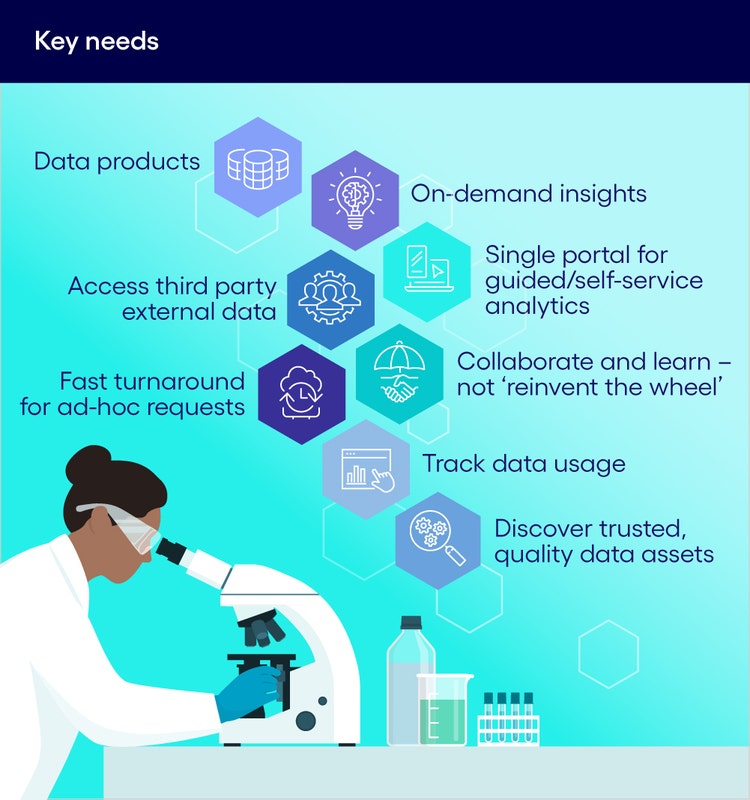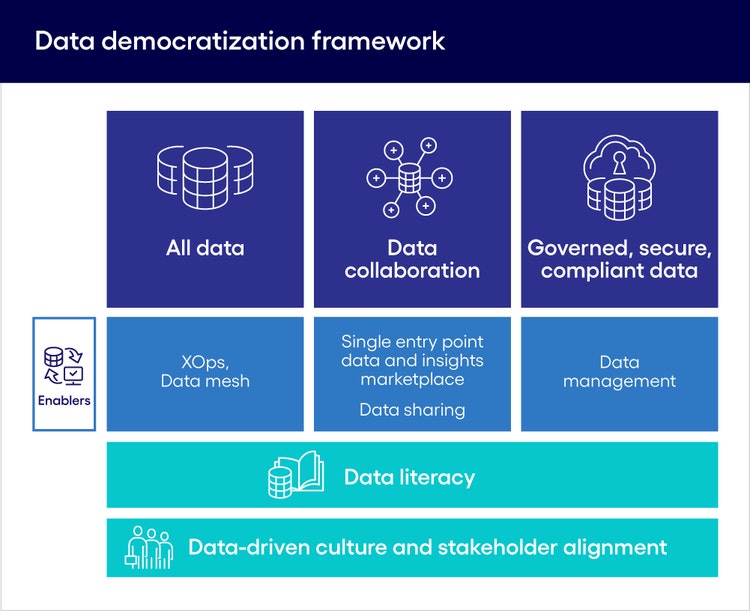<p><br> <span class="small">October 18, 2023</span></p>
Why life sciences needs shared data and how to make it happen
<p><b>To develop new treatments quickly and cost effectively, life sciences firms need a better way to share vital data, both inside and outside the organization.</b></p>
<p>If life sciences firms have learned anything in the past couple of tumultuous years, it’s that no one can bring a successful new treatment to market alone. The entire ecosystem of biopharma companies, contract research organizations, academic researchers, healthcare providers and regulators need to share data to meet the challenges of the day, from supply chain disruptions, to rising costs, to personalized treatments.</p> <p>However, many life sciences firms struggle to make data easily available across the ecosystem. In fact, many lack a clear view of their own data assets, as enterprise data—some initially collected for the use of a single business unit or geography—is often stored in systems or formats that make it difficult to access or even identify.</p> <p>Further, different users (such as data scientists and sales analysts) need different types of data, presented in different ways to make it understandable and relevant to them.</p>

#
<p><span class="small">Figure 1</span></p> <p>What’s needed is “data democratization,” which means that each user gets self-service access to trusted internal and external data, fast turnaround for ad hoc reports, and the ability to quickly uncover insights and reduce costs in the life sciences value chain. For example, life sciences firms that share information on clinical trial efficacy with healthcare providers could help ensure better patient outcomes, while researchers and scientists using a collaborative data platform could more easily search, manipulate and dock the small molecules involved in drug discovery, ultimately accelerating treatment creation.</p> <h4>Why data democratization is essential</h4> <p>With democratized access to data across the life sciences ecosystem, the following capabilities could be realized:</p> <ul> <li><b>Researchers and scientists could access more diverse and comprehensive data sets</b> to identify drug targets, design clinical trials, and evaluate drug efficacy and safety.<br> </li> <li><b>Clinicians and healthcare providers could make more informed decisions</b> about patient care and create personalized treatment plans, better diagnoses and more effective disease management.<br> <br> </li> <li><b>Life sciences firms could reduce the gap between forecasted and actual revenue</b>, especially within the context of rare disease and specialty drugs, by combining AI capabilities and real-world evidence.<br> <br> </li> <li><b>Public health officials and policymakers could better identify and track disease outbreaks</b>, monitor the effectiveness of vaccination programs, and develop evidence-based public health policies that link treatment and spending with improved outcomes.<br> <br> </li> <li><b>Life sciences firms could better capture real-world data and evidence</b> to demonstrate the value of their therapies.<br> <br> </li> <li><b>Researchers, clinicians and other stakeholders could collaborate more quickly</b> and easily to successfully meet new challenges such as future pandemics or supply chain interruptions.<br> <br> </li> <li><b>Life sciences firms could more easily and effectively prove compliance</b> with laws and regulations such as HIPAA, GxP (Good Practice) regulations, ISO 27001 and pharmacovigilance.</li> </ul> <h4>Achieving data democratization</h4> <p>Based on our work with life sciences clients worldwide, we recommend organizations adopt three technical components to enable data democratization.</p> <ol> <li><b>A hyper-automated data infrastructure</b> that combines storage, integration tools and analytics platforms to cost-effectively provide data to a variety of stakeholders. To enable a frictionless, hyper-automated data infrastructure, businesses should incorporate approaches and technologies such as "everything as a service" (XaaS), "everything as Ops" (i.e., DataOps, MLOps, AIOps, LLMOps), data mesh/fabric, AI/ML and generative AI.<br> <br> </li> <li><b>A data/insights marketplace</b> that serves as a single access point for metadata, data assets and data products, such as raw/derived data, algorithms, reports, visualizations and AI/ML models. Such a marketplace should be intuitive and based on standard ontologies (or data descriptions) so that users with any skill level can quickly find the data they need. A generative AI-based conversational interface could be incorporated into the marketplace to automatically tag and categorize data, making it easier to manage and retrieve.<br> <br> </li> <li><b>A robust governance </b>framework and tools that automatically define and execute security policies and secure mechanisms for data access, sharing and use. This requires an investment in foundational capabilities such as master data management and data quality to ensure data and analytics integrity. The framework should also define stakeholder roles and responsibilities, as well as requirements for the associated security tools and processes. Generative AI can be used for various governance tasks, such as the creation of rules and policies for sensitive/confidential data access and handling, based on learned patterns.</li> </ol>

#
<p><span class="small">Figure 2</span></p> <h4>Cultural considerations</h4> <p>Beyond the technical requirements, data democratization also requires attention to culture and change management. Stakeholders should be identified who will benefit most from improved data access, such as scientists, researchers and product managers, as well as the data that’s relevant to them. Through data literacy training and support, users should learn how to understand data and how to connect data insights into business outcomes.</p> <p>To foster a culture of data-driven decision making, the top levels of the organization should provide funding, encouragement and support, as well as share examples of using data to drive business value. Program leads should periodically seek stakeholder feedback, assess their evolving needs and make relevant changes. For example, it might become necessary to update the data used to train an AI model that identifies new potential treatments to reflect the latest pharmacovigilance data.</p> <h4>The role of partnerships</h4> <p>Many life sciences firms don’t have all the data their users need, such as the results of outside clinical studies, the genomes of diverse patient groups or potential trial sites that the company has not used before. Life sciences firms often collect data from third parties, such as IQVIA and MedPro, which requires data management, integration and analytics skills to make it available to everyone who needs it.</p> <p>By partnering with other life sciences firms, organizations can pool their resources and share the costs of the infrastructure, technology and tools needed to democratize this type of data. Collaboration can help ensure the data is collected, stored and analyzed using learnings, best practices and standardized procedures. This can improve data quality, reduce errors and increase trust in the data.</p> <p>Consortia can be formed to share data that is coming from various researchers but for a common cause. However, governance guardrails need to be established to ensure sensitive and confidential data is not shared and ensure regulatory compliance.</p> <h4>It takes a village</h4> <p>Data democratization is an imperative for the life sciences industry. By breaking down silos and ensuring widespread access to valuable information, researchers, clinicians and innovators can collaborate more effectively to achieve better patient outcomes, transparency and accountability. Organizations that embrace data democratization will drive the industry toward greater achievement and a positive impact on global health.<br> </p> <p><i>To learn more, visit the </i><a href="https://www.cognizant.com/us/en/industries/life-sciences-technology-solutions/clinical-development" target="_blank"><i>Clinical Development</i></a><i> or </i><a href="https://www.cognizant.com/us/en/services/ai" target="_blank"><i>Data and AI</i></a><i> sections of our website or contact us.</i></p>
<p>Hemant is a data & analytics leader at Cognizant with 20+ years’ experience across consulting, sales, solutioning, delivery and CRM. He is an acknowledged thought leader and speaker and has represented Cognizant at many industry and partner events.</p> <p><a href="mailto:Hemant.Singhal@cognizant.com">Hemant.Singhal@cognizant.com</a></p>

